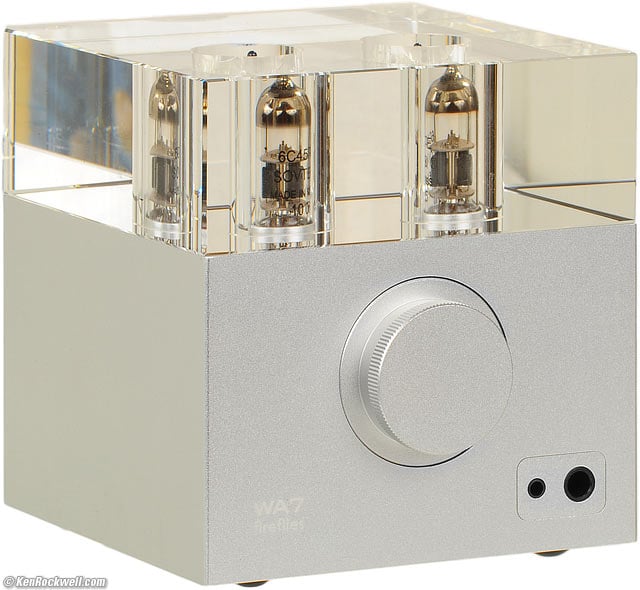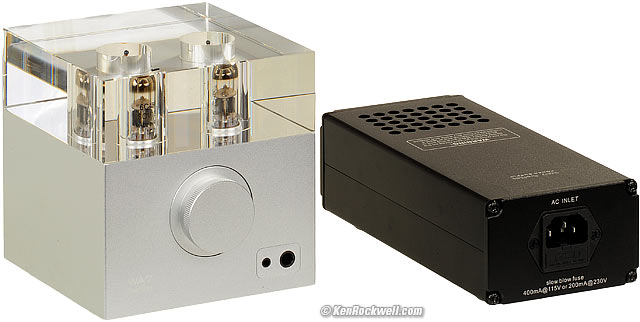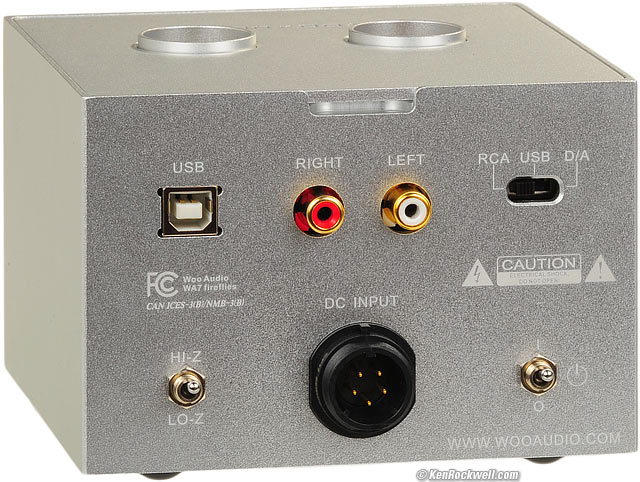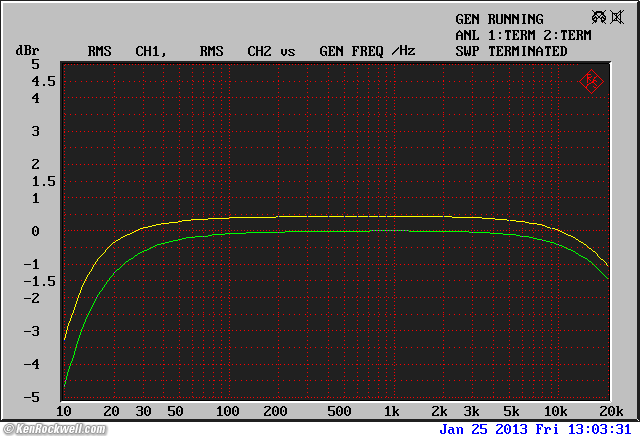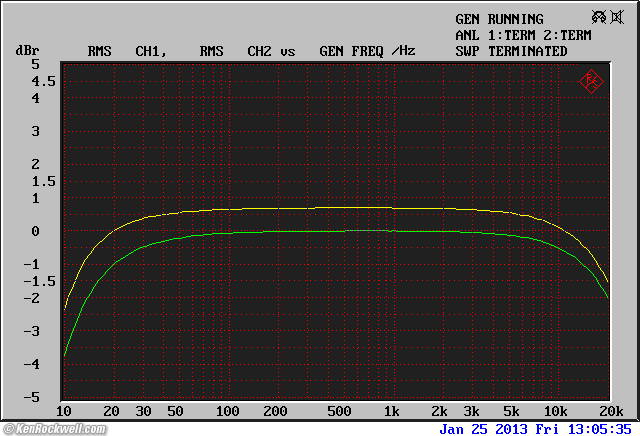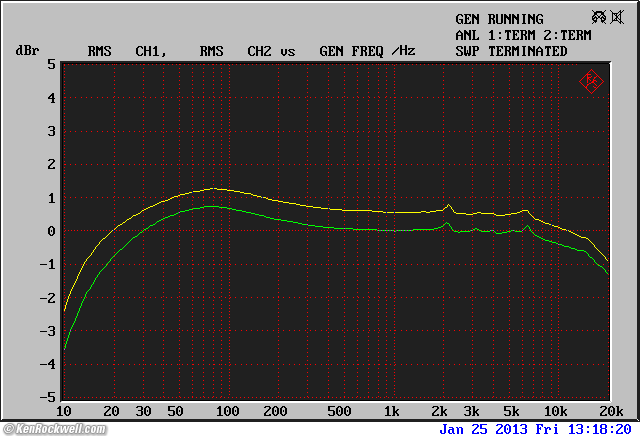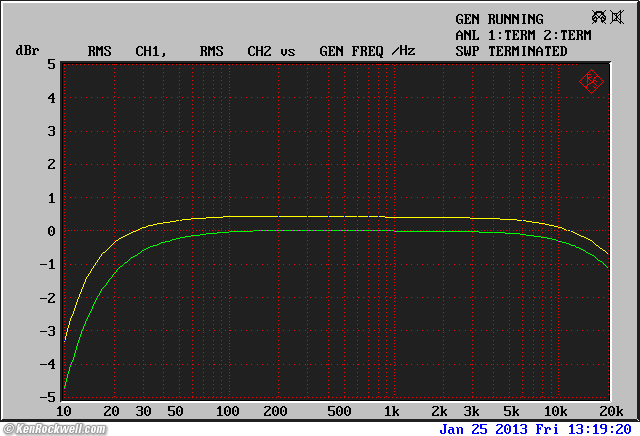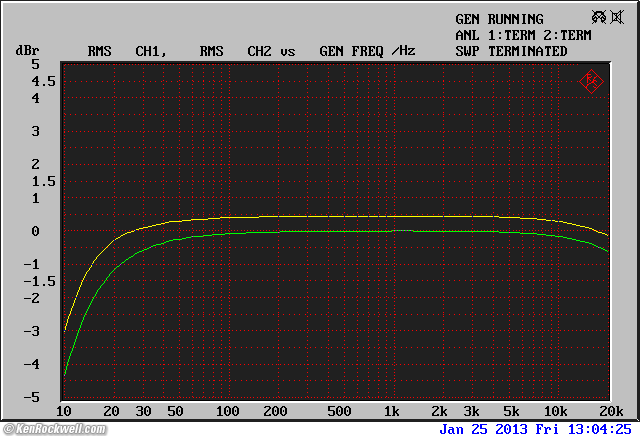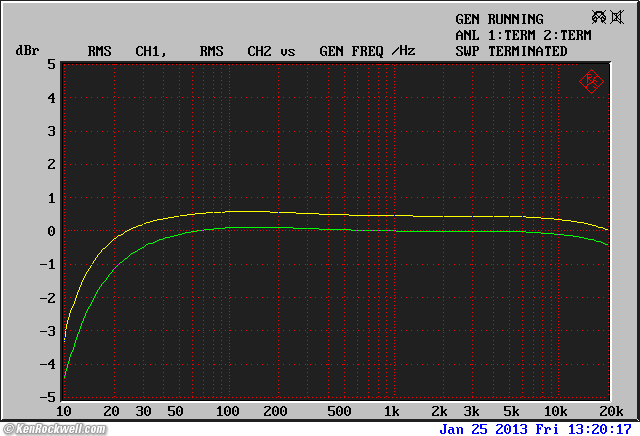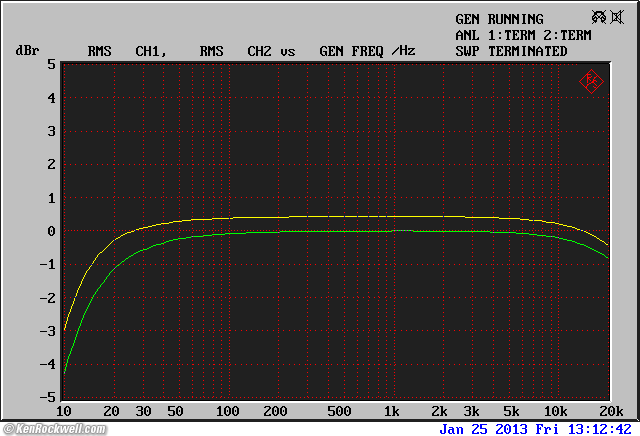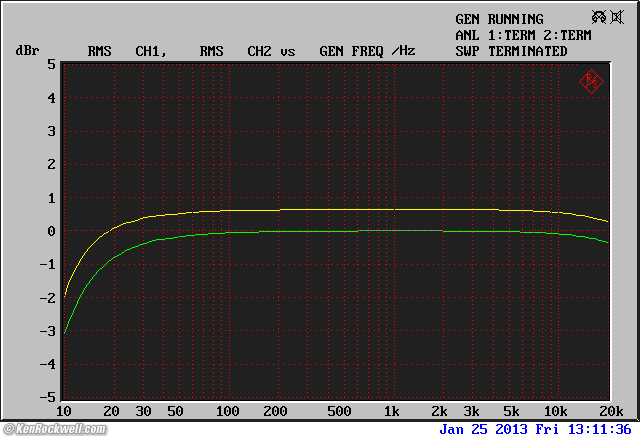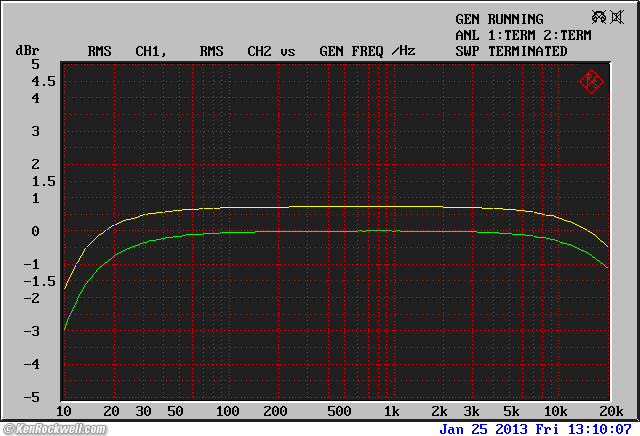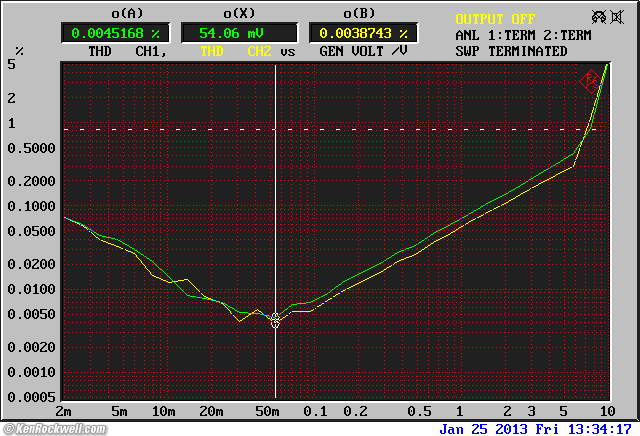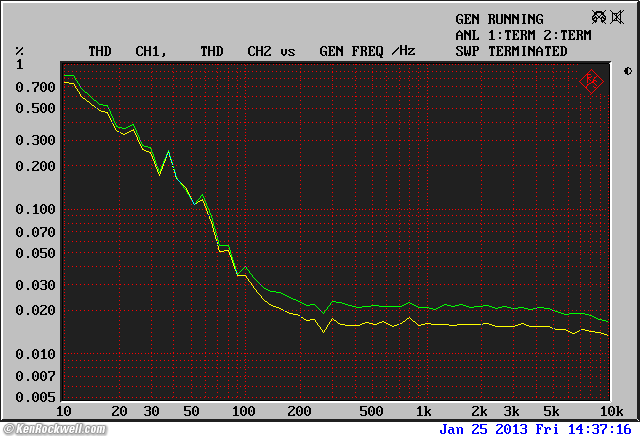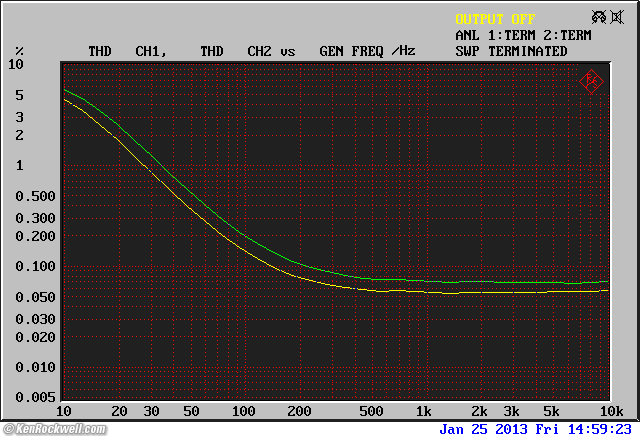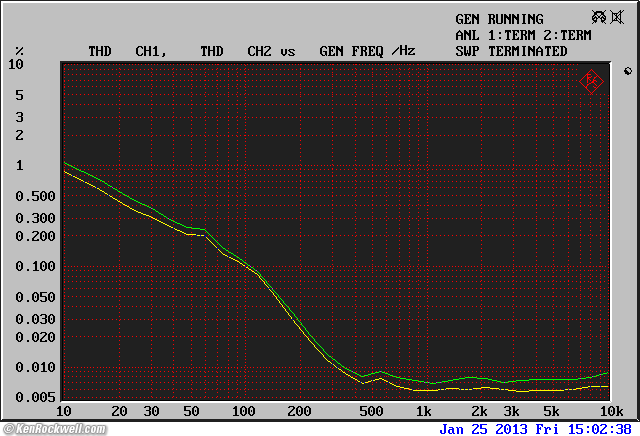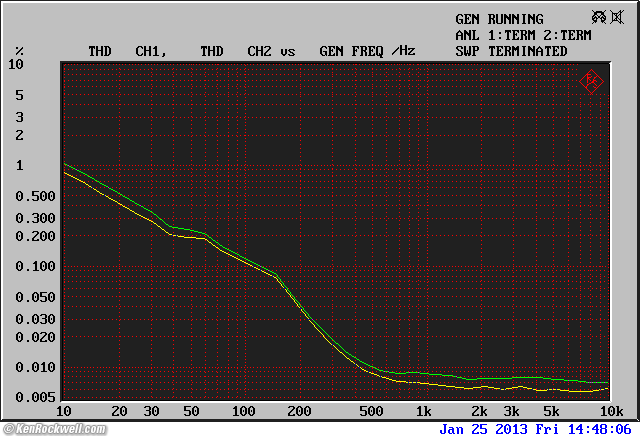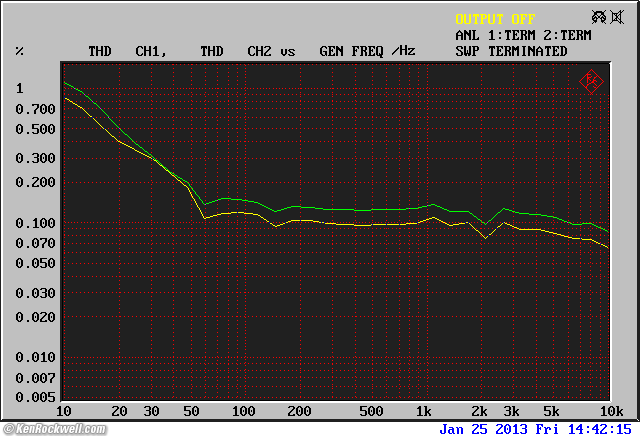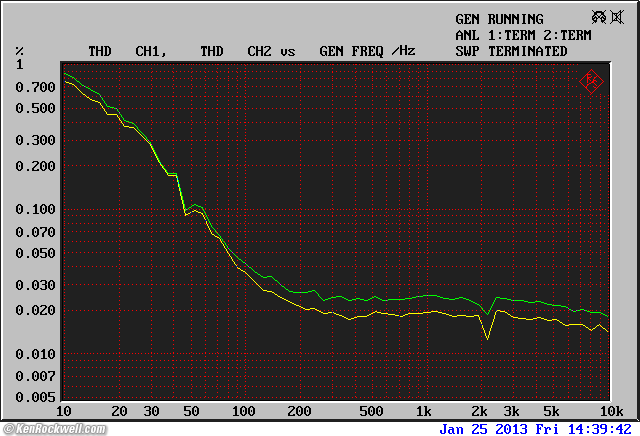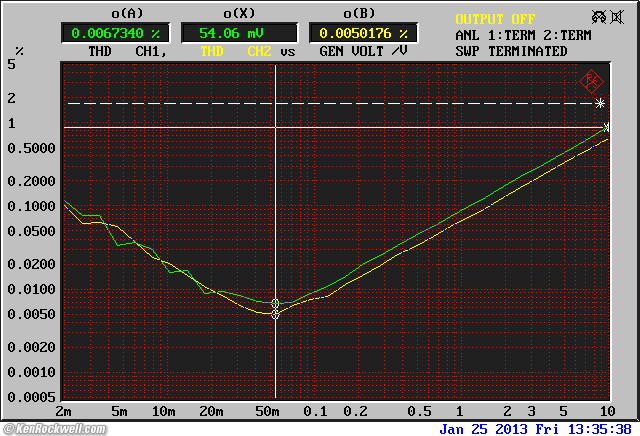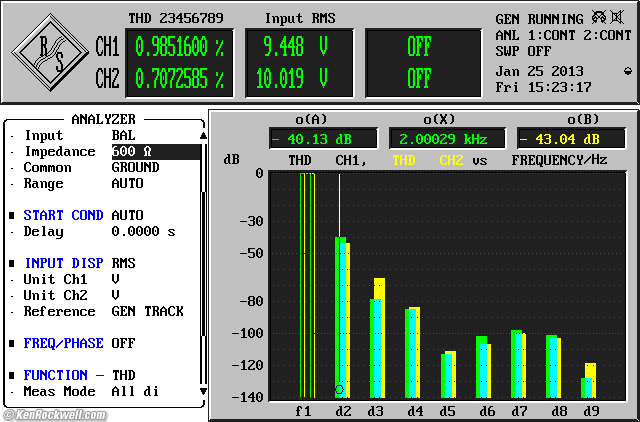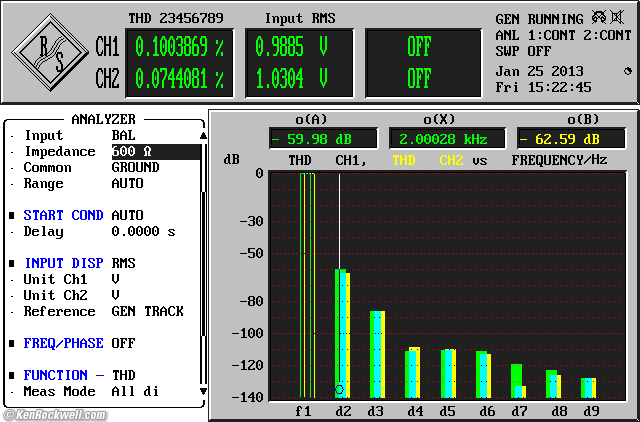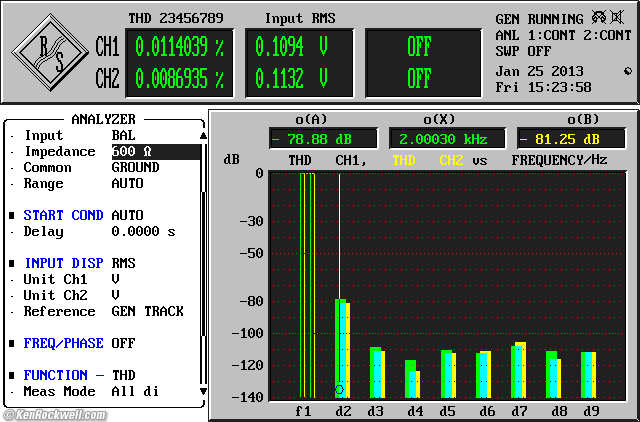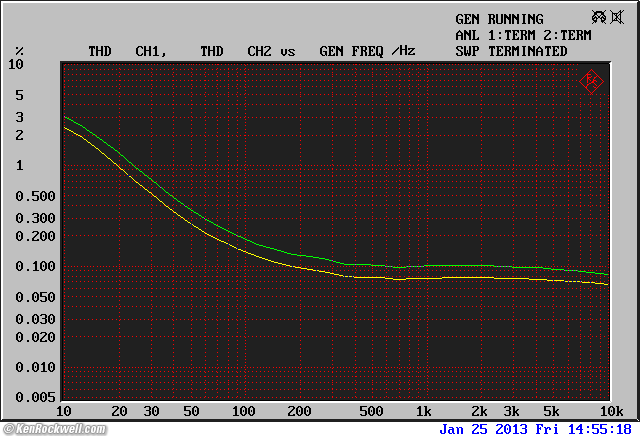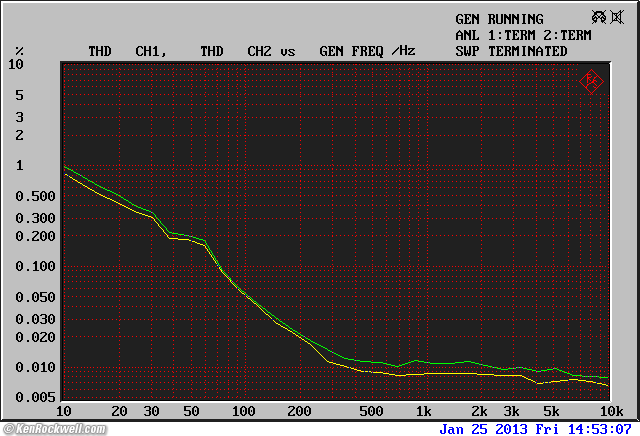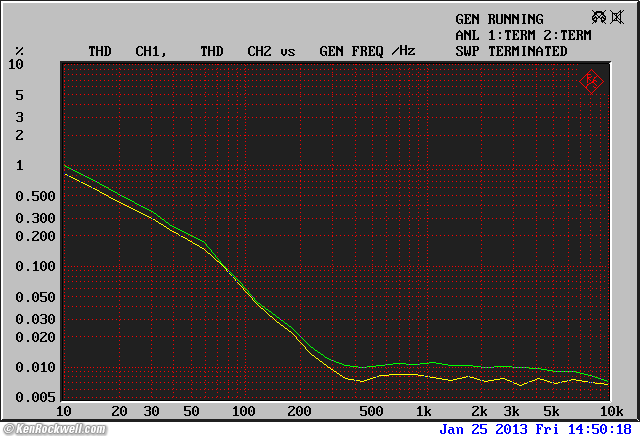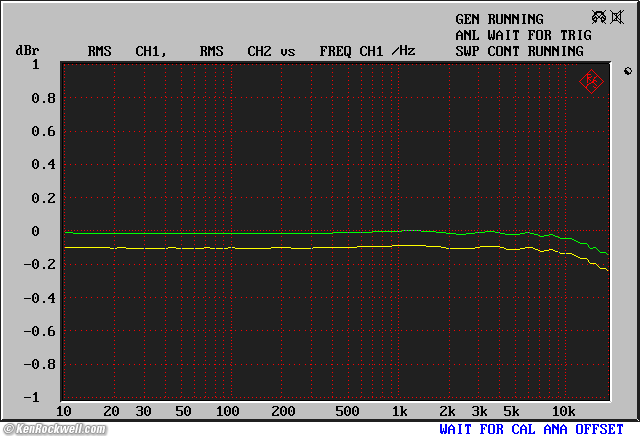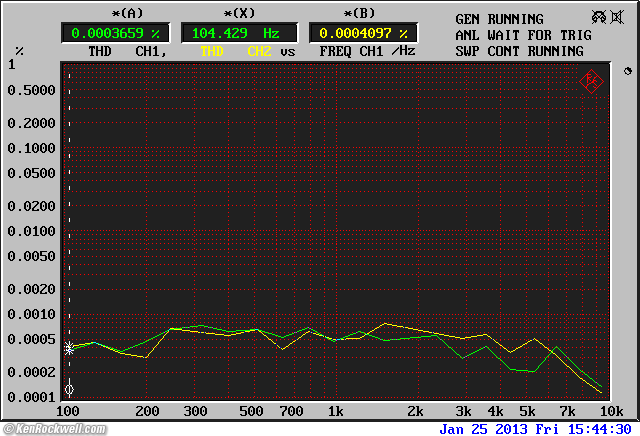Home Donate New Search Gallery Reviews How-To Books Links Workshops About Contact
Woo Audio WA7 Fireflies
Vacuum-Tube Headphone Amplifier
and USB DAC
© 2013 KenRockwell.com. All rights reserved.
Intro Specs Performance Measurements Usage Recommendations More
Woo Audio WA7 (about the size of a CD jewel box, 8.5 lbs./3,860g as shown, $999). enlarge. This free website's biggest source of support is when you use these links when you get anything, regardless of the country in which you live. Thanks! Ken.
April 2013 Woo Reviews Headphone Reviews Audio Reviews All Reviews
NEW: Why Tubes Sound Better 27 May 2015
Inputs: A stereo pair of ¼" RCA jacks and a USB jack.
Outputs: One ¼" headphone jack and one 3.5mm headphone jack. (If used as a stand-alone DAC, the stereo pair of ¼" RCA jacks becomes an output, no longer an input.)
Power: 110 VAC or 230 VAC, switch-selectable, 50/60 cps.
Notable: All-tube, all-analog amplifier sold factory-direct for a fraction of the price you'd expect for something of this quality. USB DAC included inside, too. These are well-made real-audio masterpieces: quiet, stable, loads of gain, no noise, no oscillation, perfect channel-tracking, well-designed, well-built and great-handing, great-sounding no-nonsense amplifiers.
Missing: Nothing but the high price. Of course as real, traditional all-analog amplifier, there thankfully is no baloney like remote volume controls or blinking lights. A loop-through output would have been nice so that it would be easy to insert this amplifier in-line between your sources and your regular preamplifier.
Introduction top
Intro Specs Performance Measurements Usage Recommendations More
The Woo Audio WA7 Fireflies is a marvelous amplifier. Not only does it sound fantastic with loads of output and control for smooth and detailed sound against a jet-black background of complete silence with any headphone, it's super well-made out of heavy metal with a real volume control that provides instant setting of any volume level with the single flick of a finger, and has perfect left-right channel tracking sorely lacking in most other amplifiers. Heck, the left and right channels track perfectly in the WA7, far better than the Benchmark DAC1 HDR which sells for twice the price.
I've never heard a better-sounding headphone amplifier than the WA7, and it's built like a tank, feels great, and has a super-bargain price. It's a real all-tube amp, not an imitation "hybrid."
The WA7 is an all-vacuum-tube transformer-coupled headphone amplifier, along with a USB DAC in the same small case. The name "Fireflies" comes from the look of the little tubes lighting up inside the removable solid-glass top safety cover. The WA7 is about a millimeter smaller on each side than a Compact Disc. A CD case is slightly larger than the top of this amplifier - but don't put anything on it so it can ventilate properly!
It's small, but packs huge performance inside its heavy package. It's so heavy that you don't need to hold it when inserting or removing headphone plugs — it stands solidly on your desk just like a much larger amplifier. That's more great news: with the WA7, you don't need a 17" or 19" wide amplifier for professional performance; it all fits on your desk next to your workstation and other monitors.
The WA7 is a marvelous amplifier, designed and meticulously crafted as it should be. Its audio performance ranks it among the best headphone amplifiers ever made — as we'd expect from a company specializing in headphone amplifiers. Its sound is completely neutral, minus the added brightness often heard in other amplifiers. Also better than other tube amplifiers, its low-end response is solid down to infrasonics. It sounds quite similar to the Benchmark DAC1 HDR, and better than the Benchmark, its channels always match without one getting louder than the other at low volume settings.
To keep the amplifier small enough to be used in tight spaces, and to isolate the audio circuitry from the power supply, the WA7's power supply is separate. It's connected via a dedicated cord with special locking circular connectors. The power supply is not to be confused with the generic plastic supplies and warts used by other brands; the WA7 power supply is also made by Woo and has a matching serial number. It is remotely controlled from the power switch on the rear of the amplifier, and it's also made of anodized aluminum.
Woo WA7 Fireflies and included custom power supply (no cords shown). bigger.
The Woo Audio WA7 is the real thing, loaded with tons of gain and output power, a big, precise and smooth volume control that allows easy, instant adjustment over a huge range of volumes with no channel imbalance, and no noise, no oscillation, no funny business and no problems — just loads of beautiful, clean music from a perfectly constructed instrument.
Woo amplifiers are built as they should be: hand-made and all-metal, especially the knobs and switches. All the markings are engraved, not printed. At any price, the Woo amplifiers are precision works of art.
The glass safety cover sits on top, held on by gravity. It's made of solid glass; one big, clear chunk with two holes for the tubes.
The WA7 is a thing of museum-grade beauty and simplicity. There are no screws visible from any direction when it's sitting on a table, and all the switches are on the back.
How can something this extraordinary be such a bargain? Easy: Woo usually sells direct, so you're paying direct. With no expensive middle-men, distributors and dealers expecting 40% margins at every step, you're getting today what would sell for many times more if it were more widely distributed. If Woo hired a copywriter to spin more audiophile BS and PR about them, he could be asking — and getting — ten times the price. It's that good, especially compared to the many poorly designed and cheaply made pieces out there selling for more. This Woo amp operates without any noise or instability or oscillation at any level. It just works as it should, with none of the funny business all too common today in what passes for audiophile gear.
The only way you'll appreciate how precisely, solidly and carefully made are these amplifiers is to own one. Everything looks the same online, which is why I've gone on about how wonderful it is to see some real gear made without compromise — and when this equipment sells for bargain prices because it's still a relatively less-known brand and sold directly, I'm all over it.
My review unit has the standard tubes, and sounds great. I didn't go for any of the upgrades.
USB DAC
There's also an integrated-circuit USB DAC inside. I won't talk about it much since there's so much more to talk about the extraordinary amplifier.
Therefore, unless I mention otherwise, I'm using the analog input as fed from analog sources.
Personally, I'm not a fan of ever connecting my computer ground to my analog audio ground, so if feeding from a computer, I feed the WA7 from a TOSLINK DAC, like my Benchmark DAC1 HDR. Optical cables make no electrical connection between the two devices, thankfully.
I'm an audio old-timer, from back when 600 Ω balanced lines really were sourced and terminated with 600 Ω — long before digital audio was invented. We old-timers only consider 110 Ω balanced or BNC 50 Ω coax as "real" digital audio interfaces, and consider SPDIF RCA or TOSLINK as consumer oddities. USB isn't even part of my audio picture; it's for connecting mice and printers — but that's just me.
All kidding aside, the USB DAC sounds transparent and just like other good DACs. If you prefer USB over TOSLINK (all Macs have dedicated TOSLINK optical audio ports; even your Macbook has them hidden inside the headphone jack if you use the right mini-TOSLINK optical cable), I hear no flaws from the Woo WA7 USB DAC; it's just not my focus since I'm working from more professional source material.
Operating Modes
Rear, Woo Audio WA7, no tubes and no safety cover. enlarge.
There are three modes, selected by a slide switch on the rear of the amplifier as shown above on the top right.
RCA
The usual mode in which I run the WA7, "RCA" takes the analog input from the RCA pair, amplifies it and sends it to the front panel headphone jacks.
USB
Set to "USB," the digital input to the USB connector is converted to analog at the internal DAC, and this input is fed to the amplifier and the front panel jacks.
Set to USB, the RCA input is ignored.
D/A
Set to "D/A," it works as a dedicated stand-alone USB DAC.
In D/A, it converts the digital USB input to analog, and this analog signal is fed to the RCA pair as an output.
The RCA pair is now a DAC output, not an input, and nothing comes out of the headphone jacks.
Specifications top
Intro Specs Performance Measurements Usage Recommendations More
Type
Two-channel stereophonic headphone amplifier.
Single-ended, class-A amplification with transformer coupled outputs.
External custom remote-controlled linear power supply.
Tube Complement
Two 6C45.
DAC
USB input via C-Media 6631 USB IC.
TI PCM5102A DAC IC.
Input data rated 32-bit at up to 192 ksps; actual DAC conversion topology not specified.
Colors
Silver or black anodized aluminum.
Clear or smoked solid glass top: clear ships with silver; smoked with black.
Inputs
Stereo pair of ¼" RCA.
100 kΩ.
(USB connector for the DAC.)
Outputs
¼" and 3.5mm headphone jacks.
Rear transformer tap switch for HI or LO impedance output.
(The stereo pair of ¼" RCA jacks becomes an output in the D/A mode.)
Output Load Impedance
Rated for 8 ~ 600 Ω loads.
(measured output source impedance is a different thing.)
Output Power
1 W at 32 Ω.
Frequency Response
11 ~ 27,000 cps @ ±0.5 dB.
Distortion
Less than 0.03%.
Signal-to-Noise Ratio
95 dB.
Power
110V or 220V, 50-60 cps, rated.
25 watts maximum, rated
Measured power consumption: 22 watts.
12 watts on cold-start measured during power-up.
0 watts (< 100 mW) measured when turned off.
Dedicated power interconnection cord: 4.25 feet (1.3 meters).
No standard HP/IEC power cord included; use your own.
Size
4.8" L x 4.8" W x 5.1" H, with glass.
7" L x 3.5" W x 2.2" H (power supply).
Weight
Actual measured
5 lbs. 3.75 oz. (2,370 g or 83.75 oz.), amplifier only.
3 lbs. 4.335 oz. (1483.6g or 52.335 oz.), glass block only.
8 lbs. 8.25 oz (3,860g or 136.25 oz.), amplifier and glass block.
3 pounds 6 oz. (1,530g or 54 oz.), power supply.
Rated
5.3 lbs. (2.4kg), excluding glass.
3.3 lbs. (1.5kg), glass only.
2.8 lbs. (1.4kg), power supply.
Performance top
Intro Specs Performance Measurements Usage Recommendations More
My unit has the standard tubes and no upgrades.
Sound
The most striking thing about the sound is how much pure and natural sound there is with any headphone, along with the complete absence of noise or crud.
The volume control is the most important control of any amplifier, and in the Woo WA7, the big, ultra-smooth pot controls the level easily over a huge range with perfect channel balance. I wish every piece of audio gear had level controls as nice as this; very few do, and it's important to keep the left and right channels balanced with each other as does the WA7.
It's smooth and detailed against a completely black background.
There's nothing but loads of clean, silent, silky-smooth, airy, wide-stage sound, dependant more on what signals you put into it and what headphones you connect than any sonic distortions from the amplifier.
The WA7 has almost unlimited gain and output. Unlike most of the weak excuses for headphone "amplifiers" sent to me for review, the WA7 easily can amplify to any desired level, and with its superb volume control, is able to adjust this easily to as much or as little as you desire. Other amps, like the Benchmark DAC1 HDR, have a far sloppier and less able excuses for volume controls, and much less gain.
The WA7 is silent. There is no noise audible at idle, even with extremely sensitive headphones like the Audio-Technica ATH-M50, Beyer T70p and Sony MDR-7506. Any noise you're hearing is in your recording, not the WA7.
Not only is the amplifier's output quiet, the amplifier itself is silent: there is no acoustic transformer or power supply buzz.
The WA7's sound is clean, detailed and neutral. I hear only a difference in level, not tonal balance, when selecting the LO or HI Z output impedance settings.
I much prefer the neutral WA7 to the slightly brighter WA6 SE. No longer do I have to chose accuracy or tubes; in the WA7, I have both. Likewise, the deep bass performance of the WA7 is superb, better then the WA6 and about the same as the Benchmark DAC1 HDR.
As hallmarks of good design, the headphone amplifiers of my Benchmark DAC1 HDR and WA7 sound pretty much alike, and sound like whatever's being fed into them as they should. They are both accurate, lacking the noise and distortion of lesser amplifiers I've spared my readers from reviewing.
Ergonomics
Look and Feel
As I covered above, I wish everything was made this well. The Woo WA7 feels fantastic, and for the price, it's a steal. Even the power supply is heavy and all-metal.
The WA7's attenuator (volume control) is better than a stepped attenuator because it's easy to turn, tracks perfectly and is as smooth as silk, with zero mechanical play.
The volume control is a dream, not only in how good it feels and how well the left and right channels track, but also for the huge range over which it operates. It has a proper audio taper, so all of the rotation range controls level well. Contrast this to the volume control of the Benchmark DAC1 HDR, which doesn't turn as smoothly, doesn't keep the left and right channels tracking that closely at low levels, and doesn't change the volume much anyway above about the 12 o'clock setting. The Woo WA7 is superb here, and this is very important.
The inter-unit power interconnection cord is so well designed that its connectors are always oriented correctly for easy connection at either end (they only insert one way).
The two-box power supply design is perfect for desktop use, since the power supply can be put hidden elsewhere.
Even the rubber feet are great; the stout amp locks itself down solidly without any worry of furniture damage. It sits so securely that one never needs to hold the amp with an extra hand; just push your headphone plug in and out and the amp stays put.
And did I tell you how much I love the volume control? It needs no clicks, and just spins smoothly and cleanly.
The shipping container is substantial, with a lot of closed-cell foam. To my astonishment, even my glass block arrived with no fingerprints! Woo does a very careful job and takes well-deserved pride in their products.
Power
I believe the WA7 has its own built-in power sequencer, so it gradually warms-up over the course of a minute.
This saves the tubes from heavy inrush currents, and saves you from wanting a "pre-heat" switch; it's all automatic. Brilliant!
Audio first appears after about 20 seconds of warm-up.
Measurements top
Intro Specs Performance Measurements Usage Recommendations More
Output Levels Output Impedances Gain Attenuator Tracking
Noise Frequency Response Distortion
I used a $50,000 Rohde & Schwarz UPL audio analyzer to perform these measurements.
The traces are color coded for the Left Channel and for the Right Channel. When they don't lie on top of each other, it's due to channel imbalance.
My WA7 has the standard tubes; nothing has been upgraded.
Output Levels measurements top
All measured with 2 V RMS input at 1 kc; clock times are gain control position.
At the ¼" jack , LO-Z setting
At 0.1% THD |
At 1% THD |
At Max. Gain |
|
600 Ω |
1.6 V RMS @ 12:30 = 4 mW |
0.7% THD @ 9.5 V @ max. = 150 mW | |
300 Ω |
1.0 V RMS @ 12:30 = 33 mW |
0.7% THD @ 9.0 V @ max. = 270 mW | |
37.5 Ω |
115 mV RMS @ 9:30 = 352 µW |
1.05 V RMS @ 1:00 = 37 mW |
5% THD @ 5 V @ max. = 667 mW |
At the ¼" jack , HI-Z setting
At 0.1% THD |
At 1% THD |
At Max. Gain or 10% THD |
|
unloaded* |
5.1 V RMS @ 1:30 |
||
600 Ω |
1.2 V RMS @ 11:00 = 2.4 mW |
11 V RMS @ 3:30 = 200 mW |
1.2% THD @ 17V at max. = 482 mW |
300 Ω |
550 mV RMS @ 10:00 = 1 mW |
5.0 V RMS @ 1:30 = 83 mW |
2.7% THD @ 15 V at max. = 750 mW |
37.5 Ω |
45 mV RMS @ 8:30 = 54 µW |
380 mV RMS @ 11:00 = 4 mW |
2.9 V RMS @ 3:30 = 224 mW |
* don't do this!
At the 3.5mm jack
LO-Z
|
At 0.1% THD |
At 1% THD |
At Max. Gain |
37.5 Ω |
55 mV RMS @ 11:00 = 81 µW |
550 mV RMS @ 3:00 = 8 mW |
1.4% THD @ 1 V @ max. = 27 mW |
HI-Z
|
At 0.1% THD |
At 1% THD |
At Max. Gain |
37.5 Ω |
18 mV RMS @ 9:00 = 9 µW |
170 mV RMS @ 12:00 = 770 µW |
9% THD @ 1.26 V @ max. = 42 mW |
Output Source Impedances measurements top
50 cps |
1 kc |
20 kc |
|
| LO-Z ¼" | 35.3 Ω |
36.5 Ω |
35.0 Ω |
| HI-Z ¼" | 107.7 Ω |
111.7 Ω |
103.8 Ω |
| LO-Z 3.5mm | 21.7 Ω |
21.7 Ω |
21.8 Ω |
| HI-Z 3.5mm | 22.9 Ω |
22.9 Ω |
22.7 Ω |
Gain measurements top
LO-Z ¼" |
Maximum gain |
600 Ω load |
13.6 dB |
300 Ω load |
13.1 dB |
37.5 Ω load |
7.5 dB |
HI-Z ¼" |
Maximum gain |
600 Ω load |
18.9 dB |
300 Ω load |
17.4 dB |
37.5 Ω load |
7.7 dB |
LO-Z 3.5mm |
Maximum gain |
600 Ω load |
-2.4 dB |
300 Ω load |
-2.7 dB |
37.5 Ω load |
-6.1 dB |
HI-Z 3.5m |
Maximum gain |
600 Ω load |
0.3 dB |
300 Ω load |
0.1 dB |
37.5 Ω load |
-3.5 dB |
Attenuation measurements top
Volume |
Relative Attenuation |
Maximum |
0.0 dB |
4 o'clock |
-0.7 dB |
3 o'clock |
-5.1 dB |
2 o'clock |
-9.0 dB |
1 o'clock |
-13.6 dB |
12 o'clock |
-17.3 dB |
11 o'clock |
-22.7 dB |
10 o'clock |
-30.3 dB |
9 o'clock |
-38.1 dB |
8 o'clock |
-55.1 dB |
minimum |
-121.3 dB |
Channel Tracking measurements top
Tracking (left-right channel balance) is essentially perfect at every setting of the volume control, far better than the Benchmark DAC1 HDR at lower levels.
Right channel level versus left channel, vs. attenuation setting. (positive means image moves to right. R&S UPL.)
Noise measurements top
Noise is inaudible, and it's inaudible at any volume setting!
The noise level doesn't vary at all with the setting of the level control.
Measured at any gain setting including maximum:
LO-Z setting, ¼"output (600 Ω load)
-105.5 dBV A-weighted.
-91 dBV unweighted.
LO-Z setting, ¼"output (37.5 Ω load)
-110.5 dBV A-weighted.
-97 dBV unweighted.
HI-Z setting, ¼"output (600 Ω load)
-100.5 dBV A-weighted.
-86.5 dBV unweighted.
LO-Z setting, 3.5mm output (37.5 Ω load)
-119 dBV A-weighted.
-110 dBV unweighted.
Frequency Response measurements top
1/4" Output
LO-Z Setting
LO-Z Output Frequency Response, 1 V RMS output, 600 Ω load. (R&S UPL.)
It's 3 dB down at 12 Hz.
The channels match. The traces don't sit on top of each other because of slight (inaudible) channel imbalance.
LO-Z Output Frequency Response, 100 mV RMS output, 37.5 Ω load. (R&S UPL.)
- 3 dB at 11 Hz.
LO-Z Output Frequency Response driving Ultrasone Edition 8, 150 mV RMS output. (R&S UPL.)
Only the slightest change when we drive a real headphone.
LO-Z Output Frequency Response driving 600 Ω Beyer DT-880, 650 mV RMS output. (R&S UPL.)
No change driving the DT-880.
HI-Z Setting, 1/4" output
HI-Z Frequency Response, 1 V RMS output, 600 Ω load. (R&S UPL.)
H-Z Frequency Response driving 600 Ω Beyer DT 880 at 650 mV RMS. (R&S UPL.)
3.5mm Output
LO-Z Setting
LO-Z Output Frequency Response, 40 mV RMS output, 37.5 Ω load. (R&S UPL.)
LO-Z Output Frequency Response, 37.5 Ω load, 60 mV RMS output. (R&S UPL.)
LO-Z Output Frequency Response, 37.5 Ω load, 250 mV RMS output. (R&S UPL.)
Distortion measurements top
All distortion measurements are continuous sine wave with a 22 kc measurement bandwidth, and include harmonic distortion components only, not noise.
1/4" Output
LO-Z setting
LO-Z THD versus level at 1 kc, 37.5 Ω load. (R&S UPL.)
LO-Z THD versus level at 1 kc, 600 Ω load. (R&S UPL.)
LO-Z THD at 1 kc at 1 V RMS, 600 Ω load. (R&S UPL.)
Aha! It really is mostly second-order distortion, which is the most musical kind.
LO-Z THD versus frequency at 20 mV RMS, 37.5 Ω load. (R&S UPL.)
As expected, the non-zero output impedance leads to greater distortion at low frequencies when driving real loads. This is still very low distortion, and it's superb for a tube amplifier.
LO-Z THD versus frequency at 1 V RMS, 600 Ω load. (R&S UPL.)
This is excellent for a tube amplifier, and this is at levels higher than you'll want to drive 600 Ω headphones.
LO-Z THD versus frequency at 100 mV RMS, 600 Ω load. (R&S UPL.)
Again, great for a tube amp, and much less distortion than a real headphone itself will have.
LO-Z THD versus frequency driving 600 Ω Beyer DT-880 at 1 V RMS. (R&S UPL.)
At 1 V RMS, the DT-880 itself has more distortion at these frequencies.
LO-Z THD versus frequency driving 600 Ω Beyer DT-880 at 100 mV RMS. (R&S UPL.)
At this more reasonable level, the distortion again is very low.
LO-Z THD versus frequency driving Ultrasone Edition 8 at 100 mV RMS. (R&S UPL.)
This distortion is negligible compared to the Edition 8's own distortion at these levels and low frequencies.
LO-Z THD versus frequency driving Ultrasone Edition 8 at 20 mV RMS. (R&S UPL.)
HI-Z setting
HI-Z THD versus level at 1 kc, 600 Ω load. (R&S UPL.)
HI-Z Harmonic Distortion Content 1 kc, 10 V RMS, 600 Ω load. (R&S UPL.)
HI-Z Harmonic Distortion Content 1 kc, 1 V RMS, 600 Ω load. (R&S UPL.)
HI-Z Harmonic Distortion Content 1 kc, 100 mV RMS, 600 Ω load. (R&S UPL.)
HI-Z THD versus frequency at 1 V RMS, 600 Ω load. (R&S UPL.)
HI-Z THD versus frequency at 100 mV RMS, 600 Ω load. (R&S UPL.)
HI-Z THD versus frequency driving 600 Ω Beyer DT-880 at 100 mV RMS. (R&S UPL.)
DAC measurements top
DAC Frequency Response, RCA outputs. (R&S UPL.)
As expected, the DAC is super-flat, +0, -0.1 dB from way below 20 cps to 20 kc.
DAC THD, 0 dBFS, 22 kc measurement bandwidth, RCA outputs. (R&S UPL.)
Likewise, DAC distortion is inaudible.
Output source impedance at 1 kc: 469 Ω.
| Output Noise | A-weighted |
unweighted |
| zeroes | -119 dBV |
-115.6 dBV |
| idle/mute | -119 dBV |
-115.6 dBV |
THD+N: -82.0 dB (13.3 ENOB).
THD: 0.0045% at 0 DBFS at 1 kc.
Usage top
Intro Specs Performance Measurements Usage Recommendations More
The Woo WA7 is easy to use, which is much better then most tube gear. You don't have to worry about bias adjustments or accidentally running without a load; Woo has that all figured out for you.
I prefer to use an adapter to use the full 1/4" output even with 3.5mm headphones. The 3.5mm output seems as if it's fed from a resistive attenuator from the 1/4" output. The full 1/4" output is so quiet that it's silent, even with the most sensitive 32 Ω headphones.
The 3.5mm output mutes with a 1/4" plug plugged-in. The 1/4" output is always on, except in D/A mode.
When turned-on, audio comes-up in 20 seconds, and Woo suggests a 3 minute warm up for best results.
This is a stable design; there's no manual bias setting needed when changing tubes.
Woo says use whichever HI-Z or LO-Z position sounds best to you. The HI-Z setting will sound louder with high-impedance headphones, but also drives them from a higher source impedance.
It's rated to drive 8 Ω loads, but I haven't been silly enough to try driving loudspeakers with it. The WA6 did do OK for driving desktop speakers. For headphones, either impedance setting has more than enough power.
See also Woo's WA7 Instruction Manual.
Recommendations top
Intro Specs Performance Measurements Usage Recommendations More
Woo makes the best tube headphone amplifiers there are. The WA7 has loads of clean, smooth gain and is unaffected by its load.
This WA7 is the best tube headphone amp I've ever heard. It works great for my 600 Ω headphones, Audeze LCD-3s, ATH-M50s or whatever I have to plug into it. The only other comparable headphone amplifier I've used is the Benchmark DAC1 HDR, which sounds very similar and sets the standard for solid-state amplification. Either is today's state-of the art.
Great sound is more about good recordings of great music and the right headphones than what sort of amplifier you use — so long as it has enough output and no noise. The Woo WA7 is accurate, detailed, smooth and quiet, but it can only do it if you use good headphones and recordings of music worth hearing. Don't cheap-out on your headphones if you're investing what becomes a four-figure amplifier; get the Audeze LCD-3s and never look back if you want them.
Don't waste your time with cheap $150 headphones. My personal favorite conventional headphones are the Beyer DT 880, 600 Ω version, a bargain at about $350, and the the Audeze LCD-3.
The only way to get better headphone sound is to use electrostatic headphones like STAX, and use them with a dedicated high-voltage amplifier. Woo makes those amplifiers, too, as well as is the USA's STAX dealer, so if you really want the best, step right up to those.
If you get any of this — and you should — tell them I sent you. As far as I know, your amplifier will be hand-built to your order.
More Information top
Intro Specs Performance Measurements Usage Recommendations More
Help me help you top
I support my growing family through this website, as crazy as it might seem.
The biggest help is when you use any of these links when you get anything, regardless of the country in which you live. It costs you nothing, and is this site's, and thus my family's, biggest source of support. These places have the best prices and service, which is why I've used them since before this website existed. I recommend them all personally.
If you find this page as helpful as a book you might have had to buy or a workshop you may have had to take, feel free to help me continue helping everyone.
If you've gotten your gear through one of my links or helped otherwise, you're family. It's great people like you who allow me to keep adding to this site full-time. Thanks!
If you haven't helped yet, please do, and consider helping me with a gift of $5.00.
As this page is copyrighted and formally registered, it is unlawful to make copies, especially in the form of printouts for personal use. If you wish to make a printout for personal use, you are granted one-time permission only if you PayPal me $5.00 per printout or part thereof. Thank you!
Thanks for reading!
Mr. & Mrs. Ken Rockwell, Ryan and Katie.
Home Donate New Search Gallery Reviews How-To Books Links Workshops About Contact

